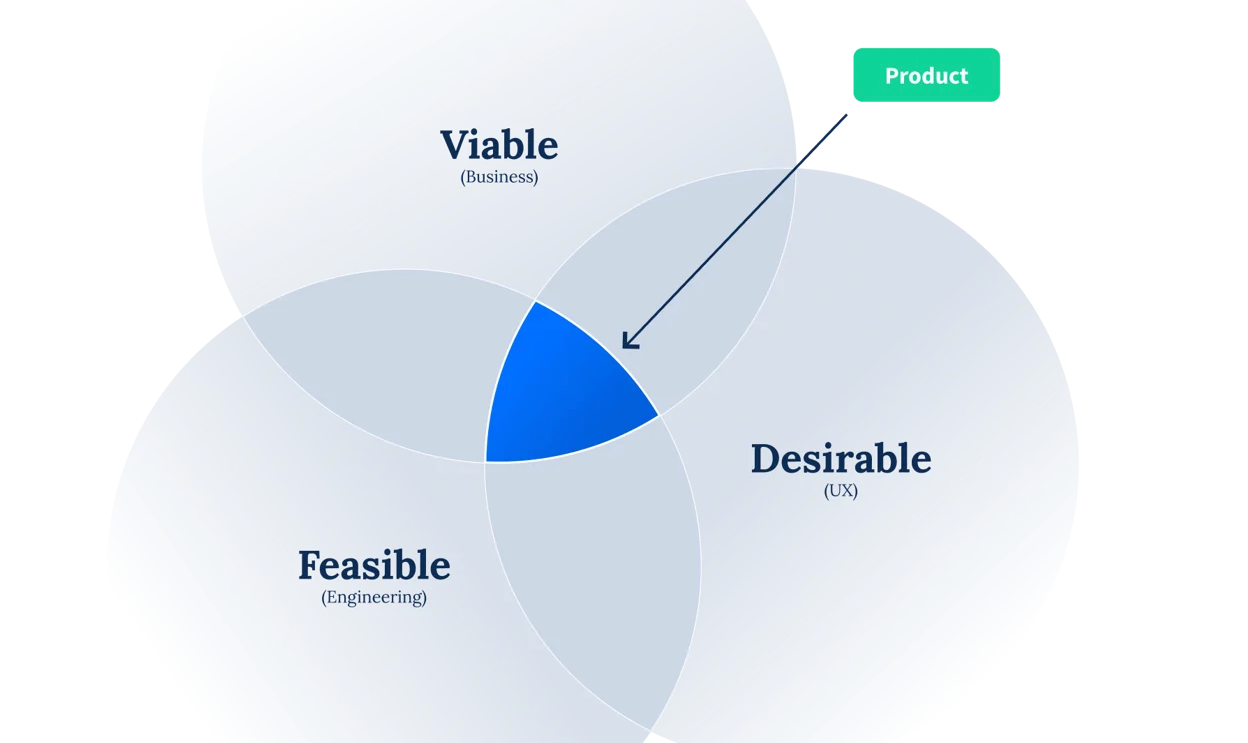Share this
The Product Discovery Imperative: Balancing User Needs with Business Viability
by Seven Peaks on Dec. 10, 2024
The Uncomfortable Truth About "Loveable" Products "Build products customers love." This maxim guides modern product creation and is rightly echoed across every startup and design team. Creating a solution that genuinely resonates with users, solves their problems, and sparks delight is critical.

But what if "loveable" isn't enough?
The uncomfortable truth is that a product, no matter how much individual users adore it, cannot survive purely on affection. Many brilliant, user-adored products have quietly withered away, leaving behind frustrated teams and empty bank accounts. This reality shows a core flaw in many discovery processes: the failure to properly check a product's true business viability before large amounts of time, money, and resources are poured into its creation.
This is expensive. At Seven Peaks Software, we understand that ensuring a product is a sustainable asset is the other, often neglected, half of the equation. Our comprehensive discovery approach is specifically designed to bridge the gap, moving beyond just user delight to validate that a product should be built in the first place, ensuring it aligns with core business objectives and a viable path to profitability. Through deep user insights combined with robust strategic and financial validation, we help our clients drive sustainable success from the very outset.
The Traditional View vs. Holistic Product Discovery
Traditionally, discovery has often been framed almost exclusively through the lens of what users want. Teams would dive deep into user research, conduct interviews, map user journeys, and rapidly prototype solutions, all with the singular aim of understanding what problems users face and how best to solve them. The implicit assumption was that if you built a product that genuinely delighted users and provided immense value, its commercial success would naturally follow.
Yet, that focus, while essential for addressing user needs, represents only half of the equation. The essential, modern understanding of discovery expands to properly check business viability before major product development even begins. It shifts the core question from merely "How do we build something customers love?" to the far more important:
"Should we build it at all, given our strategic business goals and required investment?"
This comprehensive perspective knows that a loveable product is a great start, but it fails without a clear path to profitability and sound product strategy.
The Peril of "Loveable but Unprofitable"
The consequences of pursuing a product solely for its "loveability" can lead teams down a financially unsustainable path, what we call the "passion project" trap. Here are the typical pitfalls:
- Unsustainable Scaling: An app is adored by a tiny, dedicated user base that is too small to justify the operational costs.
- Negative Unit Economics: A feature attracts users but costs a fortune to acquire (Customer Acquisition Cost, CAC), far outweighing their customer value.
- High Maintenance Costs: An innovative service is incredibly expensive to build and maintain without a clear, robust monetization model.
In each scenario, major resources are poured into something that, despite its charm, drains budgets and ultimately fails to achieve its commercial potential. Without explicit business validation, these "loveable" endeavors risk becoming distractions, preventing organizations from making truly profitable investments.
Integrating Business Goals Into Every Stage of Product Discovery
To truly de-risk product investment, business goals cannot be an afterthought; they must be woven into the fabric of discovery from day one. Doing this means moving beyond just defining user hypotheses to explicitly outlining business hypotheses.
For instance, instead of only asking "Do users need a faster way to [X]?", we also ask, "Will solving [X] generate [Y] revenue per user, or reduce operational costs by [Z]?" This comprehensive approach requires identifying key business goals upfront:
- Revenue Streams and Pricing Model: How will the product generate value?
- Cost Structure Analysis: What is the true cost of building and maintaining the solution?
- Market Assessment: Calculating the Total Addressable Market (TAM) and Servable Addressable Market (SAM).
Collaboration becomes paramount, extending beyond the typical product-design-engineering trio to include finance, sales, and marketing. By bringing these perspectives to the table early, teams can use low-fidelity business validation techniques, like sketching out a business model canvas or performing quick unit economics modeling, to ensure the product not only resonates with users but also makes sound financial sense for the organization.
Shifting the Mindset for Sustainable Growth

Embracing this holistic view of discovery requires a basic mindset change. Product managers evolve into true "mini-CEOs," not just user advocates, but leaders who understand the market's P&L and strategic imperatives. Engineers become true collaborators who grasp the commercial "why" behind the technical "how," and designers intentionally design for commercial impact, crafting experiences that drive conversion and monetization.
This shift helps teams ask the tough questions early, leading to better decisions and a culture that redefines success. It encourages celebrating the courageous decision to "kill ideas early" that prove not viable, understanding that this learning saves valuable resources and redirects effort towards genuinely profitable ventures. The focus moves from merely shipping features to achieving tangible business outcomes like profitability, market share, and long-term growth.
Conclusion: The Power of Holistic Discovery
Ultimately, while the allure of creating a product that customers absolutely adore is powerful, true and lasting success demands more. Modern discovery is a sophisticated, dual-lens approach that simultaneously evaluates user desirability (will customers love it?) and business viability (will it make sound business sense?).
This broader perspective lets organizations properly check their assumptions about both user needs and market potential, ensuring that every investment in product development is strategically sound and financially justified. By committing to discovering profitable products that are not only adored by users but also drive long-term growth, companies can truly de-risk their investments and build for enduring success.
At Seven Peaks Software, our commitment is to guide our clients through this comprehensive discovery process, transforming promising ideas into truly impactful and profitable digital products.
Share this
- Product Development (86)
- Service Design (67)
- Data Analytics (53)
- Product Design (51)
- Industry Insights (48)
- AI Innovation (38)
- Career (32)
- Product Discovery (30)
- Product Growth (28)
- Quality Assurance (28)
- Cloud Services (25)
- Events (24)
- PR (9)
- CSR (7)
- Data (3)
- AI (1)
- Data and Analytics (1)
- Digital Product (1)
- InsurTech (1)
- November 2025 (8)
- October 2025 (4)
- September 2025 (4)
- July 2025 (2)
- June 2025 (9)
- May 2025 (5)
- April 2025 (2)
- March 2025 (3)
- February 2025 (3)
- January 2025 (3)
- December 2024 (6)
- November 2024 (4)
- September 2024 (4)
- August 2024 (3)
- July 2024 (6)
- April 2024 (1)
- March 2024 (7)
- February 2024 (14)
- January 2024 (12)
- December 2023 (9)
- November 2023 (9)
- October 2023 (2)
- September 2023 (7)
- August 2023 (6)
- June 2023 (4)
- May 2023 (4)
- April 2023 (1)
- March 2023 (1)
- November 2022 (1)
- August 2022 (4)
- July 2022 (1)
- June 2022 (5)
- April 2022 (6)
- March 2022 (4)
- February 2022 (8)
- January 2022 (4)
- December 2021 (1)
- November 2021 (2)
- October 2021 (2)
- September 2021 (1)
- August 2021 (3)
- July 2021 (1)
- June 2021 (2)
- May 2021 (1)
- March 2021 (4)
- February 2021 (5)
- December 2020 (3)
- November 2020 (1)
- June 2020 (1)
- April 2020 (1)
- January 1970 (1)